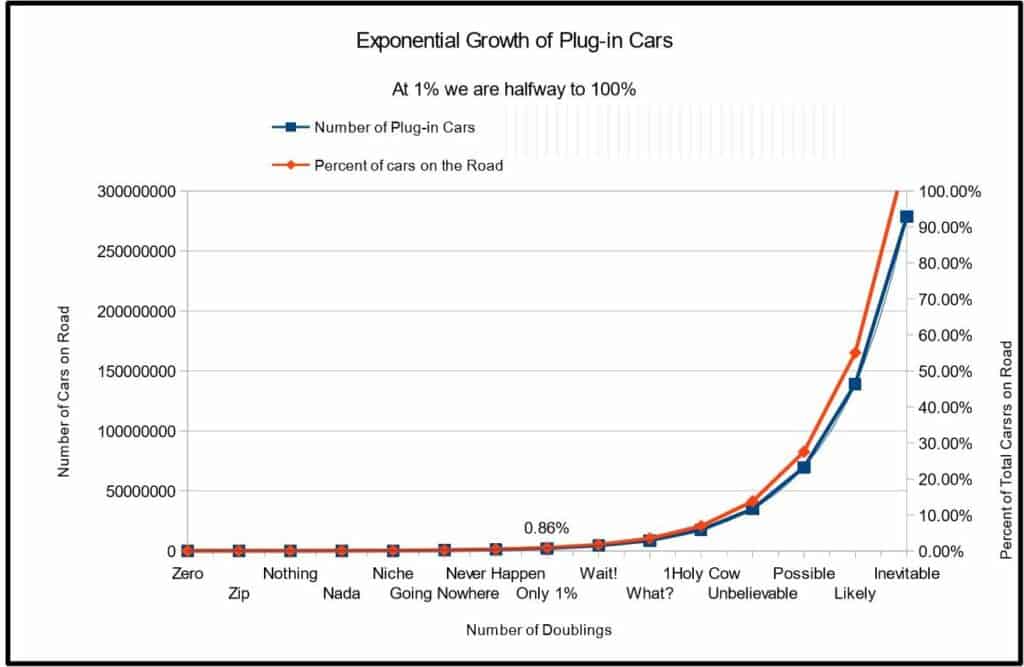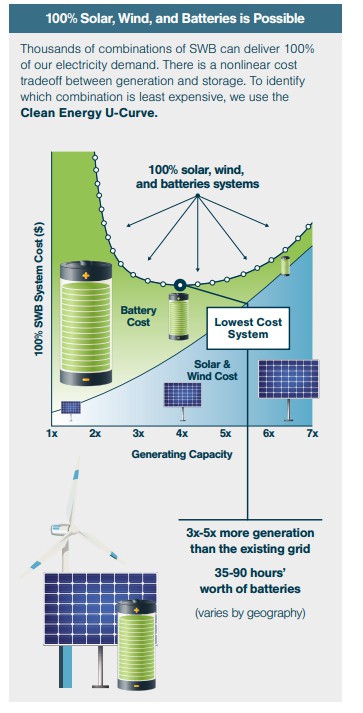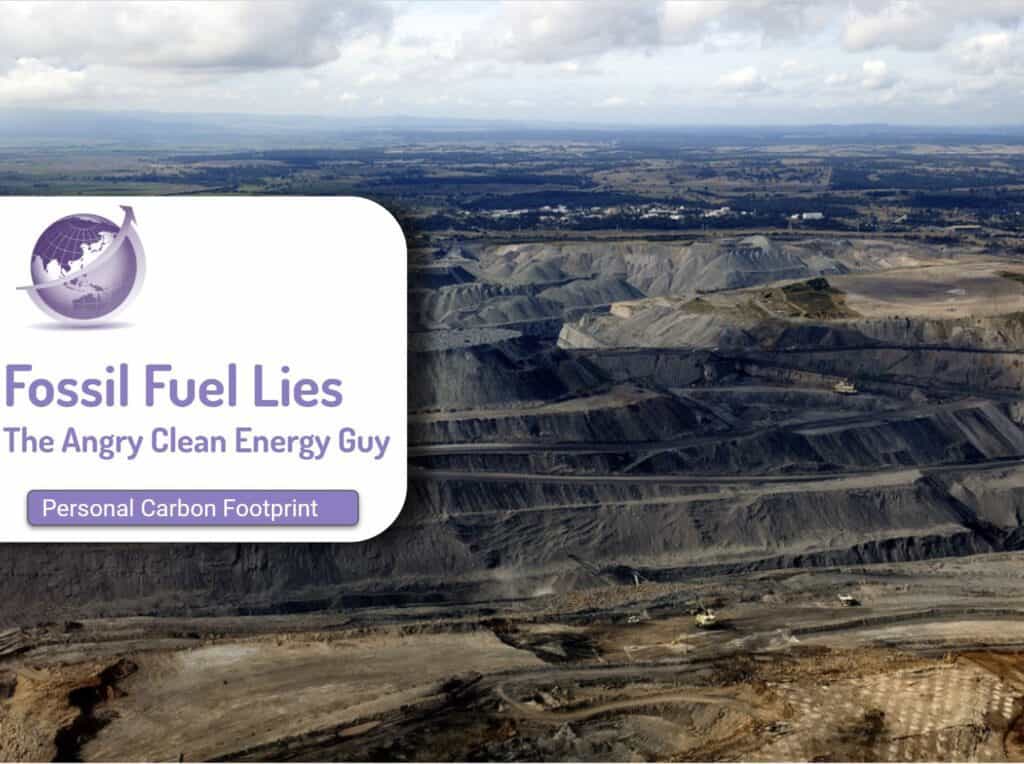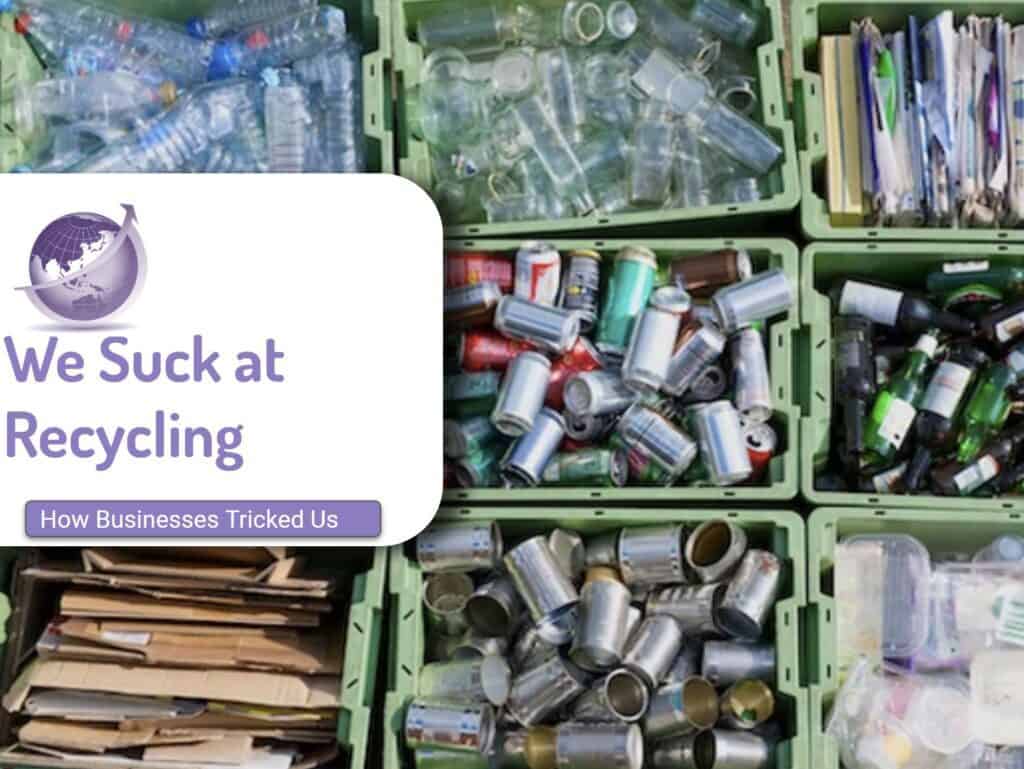Renewable Energy Transformation can provoke discussions with multiple friends and leave them misunderstanding the whole environment about changes to Renewable Energy and where energy will be by 2030 (not 2050). So I have pulled the conversation threads together to put across a viewpoint that many disagree with. My knowledge is based on being involved in renewable energy for over 40 years. Firstly in 1978 doing agricultural trials in growing beets for biofuels, to owning a solar business for 3 years, and a passion for how innovation is adopted.
Australia Can Get to 400% Renewable Energy by 2030. Will it?
The evidence is mounting that Australia, as well as UK and other countries can. So what is holding us back?
These Issues Confound all Discussions
The arguments for and against 100% energy are in these areas.
- Disruption by Technology is Not Clearly Understood.
- Technology of Renewable Energy is multiple technologies.
- Technology for high energy use industries – refineries, transportation, agriculture
- Missing Technology and what research may fill the gaps
- Economics
- Geo Political
- Speed of Change
One of the key issues is that people only change because they make money, they lose money or it’s the law. so we need to understand the drivers and the perspective that the various agents of change bring.
Australian 100% Renewable Energy Model
Dr David Osmond has a model using real demand data and has added 117% of Renewable energy.
Thread: Each week I run a simulation of Australia’s main electricity grid using rescaled generation data to show that it can get very close to 100% renewable electricity with just 5 hrs of storage (24 GW / 120 GWh)
— David Osmond (@DavidOsmond8) March 22, 2023
Results:
last week: 100% RE
last 82 weeks: 99.2% RE (1/4) pic.twitter.com/02wx7XYNrZ
How Do we Discern Mistruths and Lies
Keep in mind that we are in a transition. There are very large corporations and politicians who have staked their reputation and business on one side of the discussion. The stakes are very high – much bigger than the fight to ban tobacco. We are in a phase of change where one could take data and argue both sides. The challenge is to discern who is telling porkies, and who is not.
1. Disruption – As a Science
Many people think that disruption is linear. But Tony Seba shows clearly that when something is 10 times lower cost, disruption is inevitable.
Who Is Tony Seba? He is a futurist and for 20 since Harvard and MIT days says that when you have a 10 times cost down, you have a disruption. Furthermore, he contend experts get it wrong due to their linear view of the word A 10 times reduction in cost will drive change. (He suggests 5 times or less is not enough). His transportation one is a good intro to disruption. (but it is an hour-long https://youtu.be/O-kbzfWzvSI)
Tony Seba’s predictions have been true since his early work back in 2000 in the academic press. By 2007 he cross the boundary to the public stage. He lays out the methodology and monitors his predictions and in most cases he has been more conservative than the reality.
Most people struggle with the exponential, non-linear growth surprise factor. In the image below it represents the gap between a straight line view of the future, and what actually happens.

Personal experience may be a good example We can understand this concept in regards to development of mobile phones, for instance. Many of us find ourselves in an unexpected situation over time. Some find they are in the place they expected, but for many life is completely unexpected. Especially if we look back 20 years.
The shape of disruption from one technology to another is an S Curve. It can take 10 years for the technology to develop, then it takes 10 years to go from under 10% to over 90%.

This figure below shows this technology adoption, in our lifetime – from dishwasher to mobile phones to electricity.
- Always an S curve
- Adoption is faster today than it was 100 years ago
- The experts always get it wrong.
- Not a one to one substitution

From Michael Felton, New York Times.
Convergence Creates Disruption
Disruptive Technologies are usually multiple technologies plus a business model. Eg. the mRNA Covid vaccines could not have come out in a matter of weeks without 20 years of genomic sequencing, AI technology, protein understanding, CRSPR, and robotic manufacturing and funding by Governments with the business model.
Eg – Autonomous Vehicle example provided by Seba

Technology For Renewable Energy
In 2020, the LCOE was cheaper for wind and solar than running an existing fossil fuel plant. The financial numbers are 20% debt with interest of 8% and 80% equity for 12% return. Moreover the cost has been a 20% decrease year on year. So this cost-down is likely to continue.

But the change over the past 12 years is showing no sign of slowing down with a 71% decrease for wind, and 90% for solar.

4 Graphs from Our World in Data




In conclusion, there is a huge amount (GW) of built or planned RE and the problem faced by Australia is that fossil fuel plants are highly probable to close down due to economic reasons within the next 5 years. Not 15 or 20.
Tidal Energy
Tidal energy has been promoted for decades but half billion dollar investments have been made with no outcome. https://www.energystartups.org/top/wave-energy/ There is a novel technology that is in pilot mode in Australia – it uses a unidirectional air turbine (reverse blow hole action) and only air coming into the barge. The ocean is tough to work with. And seas go calm. This is new technology and while promising may wind up like many technologies and not go go anywhere Will Wave Swell https://www.waveswell.com/ be the first that actually works. (Guardian article)
Nuclear
Nuclear is often promoted as part of the mix but cost has increased over the years, and appetite for nuclear has gone down. Proponents suggest small modular nuclear systems. Greentech Media has a good summary – looks like they may be 20% cheaper than large systems but in the past few years nuclear companies have gone bust, and new constructions have tended to balloon out in cost and huge government subsidies bail them out. Too little, too late The LCOE of large scale PV or Wind is under $30 per MW, Nuclear is $200 and increasing. So it hard to understand what new innovation will come along and make nuclear a realistic option.
Geothermal
Another form of RE but the returns don’t appear to be there. Drilling, steam and mechanical parts with high wear are expensive. It may be possible but the challenges will be sufficient R&D to make it economic
SuperPower Concept
Economic research over the past 5 years has developed a concept that 1 to 1 substitution of fossil fuel energy to renewable energy is not the right way to think about it. What the modelling shows is that the cheapest system of RE is actually 3 to 4 times overbuilding, and that gives Superpower. A 20% extra investment in RE provides 3 to 5 times of free energy – and this superpower is effectively free. There are no fuel costs.
So where does this free energy go?
Some have suggested new uses
- Development of hydrogen to sell to energy poor countries
- New energy-intensive business
- Transportation
- Agriculture
Requires –
- Battery storage for up to 4 days.
- Good transmission links – this provides robustness over distance. For example it may require links from North Queensland to Victoria rather than links from east to west, even though the West can provide 3 hours extra solar.
- Computer systems to control behind the meter
- Improved network management
- Change in pricing
We are seeing this program now with the NSW Renewable Energy Plan where they plan to overproduce by 300%.
Batteries Are Included
Batteries technology include batteries such as lead acid, flow cycle, Lithium Ion, other battery technologies but also include hydrogen production and pumped hydro, compressed air and other technologies. Anything that takes energy, stores it and can release it.
Tesla or LG Batteries are the batteries deployed today as they provide rapid response to power shortages. They can provide very fast delivery of energy back to the Grid, and allow gas energy plants to come online. While they are short term and rapid response the amount of storage currently is limited.
In contrast hydrogen and pumped hydro shows the most promise for days or weeks worth of generation.
The phrase “Superpower” coined by Tony Seba, is used to describe the power generated by renewable energy at times with zero cost which makes it available for use in generation of free stores of energy (hydrogen, or pumped hydro, compressed air or any number of storage solutionsThe NSW government worked with the Australian National University (ANU) to undertake detailed mapping of NSW. ANU has identified there are widespread opportunities across the state, with 20,000 potential reservoirs found in the landscape. These could be paired-up in different ways to create 98,000 possible off-river pumped hydro sites. Over 50 terawatts of potential pumped hydro capacity was identified in NSW.
Rethinking Energy – Tony Seba March 2021
It is worth watching this – takes 18 minutes but worth it.
Clean Energy U Curve
From Tony Seba again is that 100% Solar Wind and Batteries is possible. Models show thousands of combinations of SWB can deliver 100% of our electricity demand. There is a non-linear cost tradeoff between generation and storage. To identity which combination is least expensive they use the Clean Energy U-Curve.
The lowest cost turns out to be 3 to 5 times more generation than the existing grid, and about 35 to 90 hours of battery storage. In other words create an over supply of electricity rather than having huge amounts of storage. This will vary depending on geography. Getting to 300% RW adds about 20% more capital.

To get to 100% renewable energy is less than 1% GDP over 10 years. But creates superabundant near cost power. Seba is not alone in this thinking.
- Australia AEMO appears to have taken up that thought
- Biden has said stuff on Climate Change which suggests that his advisors in the USA are anticipating this remarkable change. Day 1. Stop the XL pipeline.
Does Australia Have the Investment Capacity
We see overseas that the cost to decarbonise USA is less than 1% of GDP. Australia would be in similar position. The only thing that has held back Australian investment is fickle Govt policy. Every analysis of what has happened shows when the Govt had a carbon policy, emissions reduced. When they don’t it rises.
The Australian Govt is out of touch with large Australian businesses who have already called on the Government to have a clear bipartisan policy. Cost per population to support these changes is not much different whether in US, UK, Philippines or Saudi. Australia has the population, free renewable resources (sun and wind?) and access to global capital to support major changes.
Politics
Managing politics is key. Take South Australia as an example. Some argue from old data such as power pricing. Ome (?????) is politics. For an interesting read look at the comments on this Conversation article on South Australia journey to transfer from gas to RE. (The Conversation). Or the recent power outage in Texas where the Governor said it was due to wind turbines, but the state energy company said it was that the water in the gas power stations froze and stopped energy production. And it is also that the power distribution company deliberately did not interconnect with neighbouring states so was unable to draw on surplus power production in those states.
Politicians appear out of touch with the dat,a Scott Morrison brought coal to Parliament or “Electric vehicles will spell the end of the Aussie Weekend) With climate change real, we need to stop burning fuel and start protecting our planet and our grandchildren’s future. Renewable energy will create jobs and prosperity, and downsides will be few and well-planned. The South Australia experience shows a successful renewables transition requires that governments:
- have enough political power to advance policies that disadvantage energy incumbents
- monitor the energy market and respond proactively to disruptions
- limit damage to displaced workers, businesses, consumers and communities.
- Ensure transmission infrastructure is near renewable resources before new generators are built.
Challenge – Refineries and Smelters
The belief systems seem to fall into 4 discrete areas
- There is no technology to make steel without coal
- RE cannot provide enough energy to power the TW (????)of power required
- RE is intermittent
- The costs / or unreliability of RE will drive refineries from Australia (confused????)
Challenges in Steel – Showcase of Renewable Energy Transformation
Steel production needs about 0.77 tonnes of coal per tonne of refined steel for new steel, and about 1 billion tonnes of coal is burnt each year. The energy value of the type of coal used for steel making is about 8 megawatt hours (MWh) per tonne. This blog post looks at how much hydrogen would be needed to support this. (Carbon Commentary 2020). Recycling steel needs very much less, but for infrastructure and steel used in construction the steel does not get recycled rapidly.
His commentary is that we would need about 2 to 3 times more RE than we currently have globally. So it is not an insurmountable step, given we are at the very early stage of RE deployment.
Green Aluminium from Renewable Energy Transformation
Australia’s largest aluminium smelter uses 950 megawatts of power, and there are 4 aluminium smelters in Australia and many other major users of energy needing continual high usage of energy.
There is a view that we need to continue with fossil fuels until Australia can afford to gradually change over to lower/no carbon produced energy. The other alternative is to close these high usage plants down. That we need to continue with fossil fuels is deeply flawed.
For aluminium, every tonne needs about 15 MWh. A good case study is the closure of the Rio Tinto Twai Point in NZ. The information states that the bill for energy was going to go from $40m a year to $65m and the commentary that the Rio Tinto had huge subsidies on their operations – essentially a wages subsidy of over $1b over 10 years. Furthermore the 400 (or maybe 800) workers could be reduced by 70% with automation. The plant was built in 1970, and not fit for purpose in 2021
Tiwai Point’s operations require a monstrous amount of power, using approximately one third of the total electricity consumed in the South Island and 13% of the total electricity in NZ. It uses about 570 MW – over 2 x transmission lines from Manapouri.
In other countries such as Australia, that power was subsidized by governments – be they hydro-electric or fossil fueled. It an aluminium plant uses say 1GW and the cost of RE is $30 and the cost of fossil fuel is $50 then power savings would suggest the change should have been 2025, not 2040. The only reason not to change will be government subsidies and politics, and if there is sufficient RE to meet the demand.
An Australia report recently said the amount of added electricity generated by new wind and solar projects added between 2018 and 2025 could grow to 70,000GWh or 28GW – enough for 20 aluminium smelters.
Clear there is enough RE coming online to meet peak demand – the issue is storage and we already know that Snowy 2, Kidson, and other pumped hydro could meet the demand.
Technical Aspects of Renewable Energy Transformation
It appears from the following articles say the technology exists today, and is currently in scale-up mode. The carbon required for steel can be supplied by sources other than coals such as graphite.
The issue appears to be higher cost or unreliability of RE. The answer to that is superpower which is essentially free, and sufficient low cost storage – batteries, pumped hydro and wind power.
- https://www.wired.com/story/how-steel-might-finally-kick-its-coal-habit/amp
- Back in 2019 Thyssenkrupp showed a pilot hydrogen powered plant.
- https://reneweconomy.com.au/another-nail-in-coals-coffin-german-steel-furnace-runs-on-renewable-hydrogen-in-world-first-55906/
An alternative view is that Australia is ideally suited to bring smelters back to the mines.
- Over the last 50 years, refineries or smelters are in low cost or subsidised energy countries with cheap labour. They have become uneconomic in Australia and NZ due to cost of fossil fuels energy and high labour costs.
- Mines are in remote Australia so solar and wind are close by. Could co-locate with hydrogen batteries, large batteries etc.
- Removes all the cost of shipping ore and dirt (80% of cost is just dirt)
- Refineries costs are 30% energy costs. So if that cost is reduced by 400% (400 or 40??) then cost of energy in Australia will be less than fossil fuel elsewhere in the world
- Robots have reduced cost of labour.
- Now Australia is in a prime position to bring back those smelters and refineries. While they won’t have the same workforce due to robots they have:
- Superpower energy – mostly free and unlimited.
- Zero freight costs
- Unlimited source of raw materials., such as lithium, nickel and other compounds. (for producing the power?)
- Low labour costs
- not subject to shipping disruption and out of international politics
Conclusion – Steel Production Can Change Easily
A swing to hydrogen as the fuel and reducing agent for steel production will involve a major transition. Very large amounts of new renewable capacity will be required if ‘green’ hydrogen is used. The electrolyser manufacturing industry will need to expand by several orders of magnitude. And, of course, the steel industry will have to invest billions in the new plants required. Most sources suggest that for the main steel firms to make the transition voluntarily they will have to see a mixture of low power prices (say below $40 a MWh) and a reasonable carbon tax (at around $50 a tonne). These figures seems entirely attainable to me.
This will not be easy, but will be achievable. Will the political framework be adjusted to achieve net zero by 2030?
Summary
My view is that Australia is technically and financially uniquely positioned to meet a 100% renewable energy target by 2025 and to meet Superpower by 2030 and fully decarbon all industries including Transport and Industry by 2035.
The challenge is political with the entrenched fossil fuel industry and banking sector laggards.
Politics Drives Investment
This graph from EY (in PV Magazine, https://www.pv-magazine-australia.com/2023/12/07/australia-ranked-fifth-most-attractive-market-for-renewables-investors) shows where you are drives investment risk.

100% Renewable in 6 years
Mark Jacobson and others from Stanford modelled “Low-cost solutions to global warming, air pollution, and energy insecurity for 145 countries” in energy and Renewable Science. Their conclusions:
- 145 countries, 100% Renewable
- Net job increase = 28 million
- Reduction end-user energy cost = 56.4%
- Reduces energy costs = 62.7% ($17.8 to $6.6 trillion pa)
- Reduces social energy costs 92.0% ($83.2 to $6.6 trillion pa)
- Present-value cost of $61.5 trillion
- Mean payback times of capital = 5.5 years
- Mean payback time for Social Energy = 0.8 years
The latest energy system models from Stanford University researcher Mark Jacobson, show that for 145 countries, the energy transition to 100% wind, water, solar and storage would pay for itself within six years, and ultimately cost less than continuing with the current energy systems. This is inline with the predictions by Tony Seba from Rethinkx in his publication Rethinking Energy and explored more in 3 Disruptions, 8 Technologies.

Renewable Energy
- Tony Seba Energy Website https://www.rethinkx.com/
- Download the presentation https://bit.ly/rethink-energy
- Download the methodology https://www.rethinkx.com/s/Energy-Reports-Methodology.pdf
Renewable Energy – Superpower
- Tony Seba Video https://www.youtube.com/watch?v=PM2RxWtF4Ds
- Renew Economy Article https://reneweconomy.com.au/export-superpower-aemo-to-model-even-faster-paths-to-net-zero-emissions-93231/
- Kean says NSW can be renewable energy superpower, or stick its head in the sand Renew Economy June 2020
- Export superpower: AEMO to model even faster paths to net zero emissions Giles Parkinson 17 December 2020
- AEMO Draft Report https://aemo.com.au/en/newsroom/news-updates/draft-2021-inputs-assumptions-and-scenarios-report-released
- The Conversation. Against the odds, South Australia is a renewable energy powerhouse. How on Earth did they do (Google Search)
- “Tidal wave” of new wind and solar will force early coal plant closures 2021 (Renew Economy)
- Fast Erosion of Coal Plant Profits in the National Electricity Market (PDF) IEEFA Feb 2021
- New South Wales Government’s Electricity Infrastructure Roadmap (2020) (Google)
- Pumped Hydro (NSW policy)
Refineries
Texas Power Outage Wikipedia https://en.wikipedia.org/wiki/2021_Texas_power_crisis









